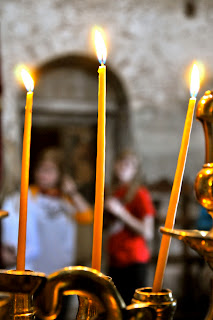MYCENAE
Today we took a bus to the citadel of Mycenae as well as to Eleusis to recite Antigone and sing cheesy American songs. I found Eleusis very interesting; however, architecture-wise it would make more sense to focus my entry on Mycenae. Anyway, as architecture goes, the citadel is one of the most typical and impressive creations in Mycenaean architecture. Mycenaean architecture was influenced over time by both Minoan and Cretan culture. A prominent feature of Mycenaean architecture is it's use of very large stone rocks. According to myth, the citadel was built by the Cyclops whom was employed by Perseus, Zeus’s son. This made total sense after looking at the ginormous rocks that made up the fortification wall. These things must have been 3x3x3 feet and had to way hundreds of pounds! This type of structure is known as a Cyclopean wall. What the 30,000 square foot structure is perhaps most well known for; however, is the lion gate entrance. The relief is made up of two large lions facing one another with their front paws on two small altars supporting a column. This had to have been one of the earliest examples of monumental structure (13th century BC) of the European culture, which is cool. Also, it was mentioned that the Mycenaean structure here was that several columns would be in the middle of the room to support the ceiling yet leaving the middle of the roof open. I imagine this was very beautiful and refreshing in the summertime. The structure probably also had a hall with an entrance on one side, consisting of a porch with two columns. This was known in Mycenaean culture as a megaron and was most likely where rituals took place.
MYSTRA
So, these are a lot of pictures. I'm sorry, but I didn't want to leave anything out! The archeological site at Mystras is the ruins of a city (churches, a castle and all) sitting at the edge of Sparta amongst the mountains. The focus of the site is the remains of the Byzantine style churches which has been restored inside and out. True to style, the red tile octagonal ad hexagonal roofs stand out in the scenery of the Peloponesse. The churches open up into large domed ceilings, a contrast to the Roman vaulted roofs, filled with colorful frescoes depicting images of Christ. These domes were typically seen as being placed over square compartments by means of pendentives. Not to mention, iconography is a big part of Byzantine churches. Byzantine architecture is concerned most with a decorated interior. In regards to the exterior, integration of thinly sliced brick mixed up between the stone was a playful surprise for the eye. Brickwork was a big part of Byzantine structure and derived almost entirely from Roman influence.
ATHENS
I am not sure that these pictures will get my point across well enough, but I will try my best with words. To sum it up- the economic crisis that has plagued Greece since the conversion to the euro is most apparent in the lack of restoration in buildings, apartments, etcetera throughout Athens. To say that the architecture is stuck in the 60's and 70's would be an understatement. Though I had seen this in our first several days in Athens, it could not have been more apparent than in our last free day. Jake and I were fortunate enough to get very lost in downtown Athens and were fortunate enough to experience the REAL Athens. No tourism, no pretty hotels. Just dilapidated houses and torn apart apartments. The conglomeration of styles of architecture is derived from all over the world- which makes sense since this city has brought people from all over the world. Athens, however, is a recently modernized city thus unlike cities like Paris or Vienna, hints of village life can still be seen. The narrow alleyways go back for ages leading to an urban jungle. Historical jems are hidden amongst the maze of urban sprawls. Local authorities are currently trying to preserve the historical aspects of Athens by carving in pedestrian streets. The area we called home is mainly composed of Neo-classical buildings that have been renovated throughout the years. Sadly, what stands out about the city is how poorly it has been left. To me, the ugly side of Athens was more beautiful than the rest.






















No comments:
Post a Comment